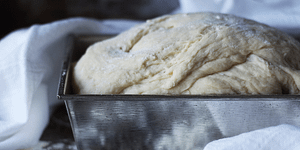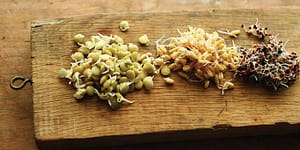Growing Shiitake Mushrooms in a Garage or Yard

Learn how to grow shiitake mushrooms in almost any environment, including your yard and even your garage!
The following is an excerpt from Fresh Food from Small Spaces by R. J. Ruppenthal. It has been adapted for the web.
How to Grow Shiitake Mushrooms
Some of the most expensive and delicious gourmet mushrooms on the market are shiitakes, which also are credited in Asia with healthful properties such as lowering cholesterol and improving immunity to cancer. They are simple to grow in logs and take about 6 to 18 months to emerge.
They can fruit in a wide range of temperatures, from just above freezing to nearly 90 degrees F. To grow shiitake mushrooms on logs, the process is as follows. You will need some hardwood logs (such as oak or beech) about 4 to 6 inches in diameter, a strong drill, shiitake spawn (preferably a strain that is suitable for your growing area; check with the supplier for more info), a hammer, and some hot wax (such as cheese wax or candle wax) that can be melted to seal in the spawn.
Procedure
-
Obtain hardwood logs. Logs that were cut recently are best, but let fresh wood sit at least six weeks before using. Leave the bark on if possible.
-
Drill rings of holes in the log 1 inch deep. Space the holes about 6 inches apart and space the rings about 1½ to 2 inches apart. If possible, alternate the holes in equal spaces and with a zigzag pattern.
-
Into these holes, insert the shiitake spawn. You can order this from suppliers in three forms: inoculated wooden
-
dowels, loose sawdust, or pressurized sawdust pellets. If you get them in dowel form, pound these into the drilled holes with a hammer. Otherwise, insert the sawdust spawn into the holes.
-
Most people like to seal in the spawn with hot wax, which provides a sterilized outer edge and prevents insects or animals from interfering during the incubation period.
-
The mycelium typically will take 6 to 18 months to grow out through the wood. During this time, you can store the logs in a plastic bag in the garage or on the ground outside, covered loosely with a plastic tarp. Make sure to punch a few holes in any plastic covering you use to allow for adequate airflow.
-
Keep the log moist by watering when necessary with nonchlorinated water. Under ideal conditions, the plastic will help maintain humidity, but during dry spells, you should water gently as often as twice per week. Other types of log-raised mushrooms need direct contact with soil (via a partially buried log), but shiitakes do not.
-
The shiitakes will continue to bloom regularly for 4 to 5 years from the same logs. They will appear on their own schedule, but always remember to keep the logs a little moist. One secret to triggering a bloom (after the first bloom cycle) is to soak the log in ice water every two months or so. Mushrooms will appear within a week or so following the ice water treatment. You may want to alternate which log you soak so that they do not all bloom at once.
I believe anyone can be successful with mushroom cultivating at a basic level, but if you want to grow specialty varieties or turn this into a commercial pursuit, then you have a lot more to learn. Like any complex undertaking, you will need to research it well, read some books, network with a local group of mushroom enthusiasts, and learn through your own experimentation.
Recommended Reads
Recent Articles
Want to spice up your traditional bread recipes? This salt-rising bread recipe by fermentation expert Sandor Ellix Katz has all the simplicity, flavor, and uniqueness you’ve been searching for! The following is an excerpt from Sandor Katz’s Fermentation Journeys by Sandor Ellix Katz. It has been adapted for the web. What Is Salt-Rising Bread? Salt-rising…
Read MoreNothing says “spring” like a fresh, foraged meal! Savor the flavors of the season with this Milkweed Bud Pizza recipe.
Read MoreOxeye daisies are one of the most important plants for pollinators including beetles, ants, and moths that use oxeye daisies as a source of pollen and nectar. Instead of thinking about removing a plant like oxeye daisy, consider how you can improve the fertility and diversity of habitat resources in your home landscape, garden, or…
Read MoreSo you want to start reaping your harvest, but you’re not sure where to start? Learn how to break down the options of harvesting tools!
Read More







